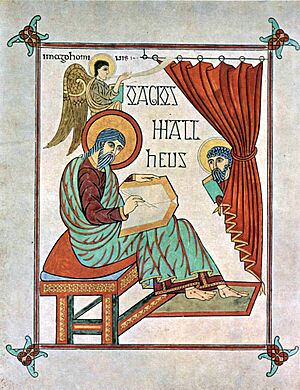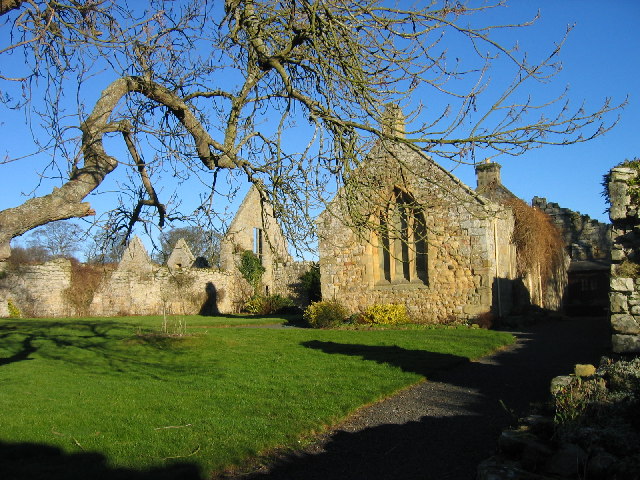History of Northumberland facts for kids
Northumberland, England's most northern county, has a long and exciting history! Long ago, Roman soldiers guarded a huge wall here. Later, Anglian invaders fought with the native Celtic people. Norman lords built many castles to control the area and protect the border with Scotland.
The county's name means 'north of the Humber River'. It used to be part of a much bigger kingdom that stretched from Edinburgh to the Humber. Because of its busy past, Northumberland has more castles and battle sites than any other county in England. It was once important for coal, which helped power the Industrial Revolution. Now, it's mostly a countryside area with a smaller population.
Contents
Ancient Times
Northumberland has a rich history from ancient times, shown by lots of rock art. Experts found a very old house at Howick from about 7500 BC! For a while, it was known as Britain's oldest house.
People also found tools, jewelry, buildings, and stone mounds from the Bronze and Iron Ages. During these times, Celtic people, like the Votadini tribe, lived here. Their land went from Edinburgh down to Northumberland. We don't know exactly where the Votadini's land ended and the Brigantes tribe's land began, but it probably changed often due to wars.
The Votadini built big walls and ditches around their farms. They also made beautiful metal objects. They had at least three huge hillforts on top of hills, like Yeavering Bell. These hillforts might have been used for over a thousand years as safe places, and for important meetings or religious events. You can also see stone circles from the Bronze Age, like Duddo Five Stones and the Goatstones.
Roman Rule
Around 78 AD, a Roman governor named Gnaeus Julius Agricola came to Britain. Most of northern Britain was still controlled by local tribes. Agricola pushed Roman control further north, even into what is now Scotland. The Romans built settlements, army camps, and roads all over Northumberland.
The Roman border in the north moved around. Hadrian's Wall was finished around 130 AD to mark and protect the northern edge of Roman Britain. Later, around 142 AD, the Romans built the Antonine Wall even further north. But by 164 AD, they went back to Hadrian's Wall because it was easier to defend.
Two important Roman roads were the Stanegate and Dere Street. Coria (Corbridge), a Roman supply base, was the biggest Roman town furthest north. Roman forts like Vercovicium (Housesteads) on Hadrian's Wall and Vindolanda (Chesterholm) had large towns around them.
The Celtic people living between the Tyne and Forth rivers were called the Votadini by the Romans. When they weren't directly ruled by Rome, they acted as a friendly buffer against the fiercer Picts to the north. The Romans slowly left Britain in the 400s AD, leading to a time of fighting and confusion as different groups battled for land.
Amazing Discoveries
In 2017, experts found nearly 2000-year-old Roman boxing gloves at Vindolanda! These leather gloves, from around 120 AD, look a lot like modern boxing gloves. They were different from gladiator gloves, suggesting they were used for sport and training, not for fighting to the death. You can see these gloves at the Vindolanda museum today.
Anglian Kingdoms

Anglian invaders created two kingdoms: Deira and Bernicia. The first Anglian settlement was in 547 AD by Ida. He and his six sons built a fort at Bamburgh, which became the main place for the Bernician kings.
Around the late 500s, Bernicia and Deira joined together under Æthelfrith of Northumbria. The land between the Humber and the Forth rivers became known as the kingdom of Northumbria.
After Æthelfrith died in battle, Edwin of Deira became king. Æthelfrith's son Oswald escaped to a Gaelic kingdom where he became a Christian. Meanwhile, Paulinus, the first bishop of York, helped King Edwin become a Christian. Under Edwin, Northumbria became very powerful in Britain.
But in 633, Edwin was defeated, and Northumbria split again. In 634, Oswald won a big battle and reunited Northumbria. He brought Christianity back and built a famous church at Hexham. Northumbria then grew, taking over land from the Picts and other Celtic kingdoms. However, in 685, Northumbria suffered a big defeat by the Picts, stopping its expansion.
Monasteries and Culture
When Saint Aidan came to teach Christianity, he chose the island of Lindisfarne for his church and monastery in 635. This became a very important religious center. One famous bishop there was Saint Cuthbert.
But in 793, Vikings attacked Lindisfarne, burning the monastery and killing many monks. The survivors rebuilt it, but in 883, fearing another invasion, they fled inland, taking Cuthbert's body and other holy items with them.
Despite these challenges, Northumbrian monasteries created amazing cultural works. Cædmon, a monk at Whitby Abbey, wrote some of the earliest English poetry before 680. The Lindisfarne Gospels, a beautiful book of gospels, was made by Eadfrith, a bishop of Lindisfarne. It's famous for its stunning and complex artwork.
Bede, a scholar from the monasteries at Wearmouth and Jarrow, was known as the most learned person of his time. His work covered history, religion, science, and literature. Bede's most famous book, Ecclesiastical History of the English People, is seen as a very important early history book.
Northumberland as an Earldom
The kingdom of Northumbria ended in 927. It became an earldom, a territory ruled by an earl, and joined England under Athelstan, England's first united king. In 937, Athelstan won the battle of Brunanburh, securing England's control over its northern lands.
The Scottish king Indulf took Edinburgh in 954, and it stayed Scottish. Later, Scottish kings tried to take more land south. In 1018, Malcolm II of Scotland defeated the Northumbrian army. As a result, the earl of Northumbria gave up all land north of the Tweed River to Scotland. This area, called Lothian, stayed Scottish.
The name "Northumberland" as we know it today was first written down in 1065. It was in the Anglo-Saxon Chronicle when it talked about a rebellion.
Norman Conquest
Northumberland strongly resisted William the Conqueror. Because of this, William punished the area harshly, especially south of the River Tees. The Anglo-Saxon Chronicle tells us about the violence and destruction.
The Normans rebuilt the old Anglian monasteries at Lindisfarne, Hexham, and Tynemouth. They also built new Norman abbeys like Newminster (1139) and Alnwick (1147). Many castles were built too, including Newcastle (1080), Alnwick (1096), Bamburgh (1131), and Warkworth (1205). These castles were important for defense and control.
Northumberland county isn't mentioned in the Domesday Survey, a big survey of England from 1086. But records from 1131 show that the county was already being managed.
In 1237, Scotland gave up its claims to Northumberland in the Treaty of York.
During the time of Edward I (1272–1307), Northumberland stretched between the Tees and the Tweed. It had several special areas called "liberties" that were ruled by others, like the bishop of Durham or the archbishop of York. Over time, many of these areas became part of Northumberland county.
The main court for Northumberland was held in different towns like Newcastle and Morpeth. By 1549, it was decided that the court should always be held at Alnwick.
Border Wars and Reivers

From the Norman Conquest until England and Scotland joined under James I and VI, Northumberland faced constant attacks from the Scots. Castles like Norham, Alnwick, and Wark were captured many times.
In 1174, William I of Scotland, also known as William the Lion, was captured near Alnwick during his invasion. This event is called the Battle of Alnwick. In 1314, King Robert Bruce attacked the county. The Scottish threat was so serious that in 1382, the Earl of Northumberland was ordered to stay on his land to protect the border. In 1388, Henry Percy was captured, and 1500 of his men were killed at the battle of Otterburn, a famous battle told in a song called the ballad of Chevy Chase.
In 1462, castles like Alnwick and Bamburgh supported the Lancastrian side in the Wars of the Roses. But after big Yorkist victories in 1464, they surrendered or were captured.
In September 1513, James IV of Scotland was killed at the Battle of Flodden on Branxton Moor.
Later, in 1569, some Roman Catholics in Northumberland supported Mary, Queen of Scots, leading to a rebellion called the Rising of the North.
The border region was also home to the Border Reivers, families who raided across the border for cattle and goods. To protect themselves, people built strong, small towers called Peel towers.
Union and Civil War
When James VI and I became king of both England and Scotland, he stopped the lawlessness of the Border Reivers. This brought more peace to the region.
During the English Civil War in the 1600s, Newcastle was held by the king's supporters. But in 1644, Scottish forces captured it. In 1646, King Charles I was brought there as a prisoner.
Many important Northumberland families lost everything during the Jacobite rebellion of 1715.
Industrial Growth
People in Northumberland have used the area's natural resources for a very long time. Romans used coal here, and some coal ornaments from the 600s have been found. In the 1200s, there's a mention of a road for carrying coal from the coast near Blyth. The Blyth coal fields were used for hundreds of years.
The coal trade on the Tyne River grew quickly from the 1200s onwards. Newcastle became the main place for shipping coal. Lead was also sent from Newcastle in the 1100s, likely from Hexhamshire, where lead mines were very busy.
Salt was made at Warkworth in the 1100s, and the salt industry was big near the mouth of the River Blyth in the 1200s. In the 1400s, making salt was the main job for people in North and South Shields. During the time of Elizabeth I, glass factories were set up in Newcastle by people who had fled from other countries. This industry quickly spread along the Tyne.
Tanning (making leather) and fishing for salmon in the Tyne were also important industries long ago.
Northumberland was also a place of innovation:
- John Smeaton designed bridges at Coldstream and Hexham.
- Stephenson's Rocket, a famous early steam locomotive, was built nearby.
- The steam turbine, a key invention for generating electricity, was invented by Charles Algernon Parsons.
See also
- Northumbria
- Northumbria's golden age
- Earl of Northumberland
- History of England
- Kingdom of England
- Timeline of Northumbria and Northumberland





